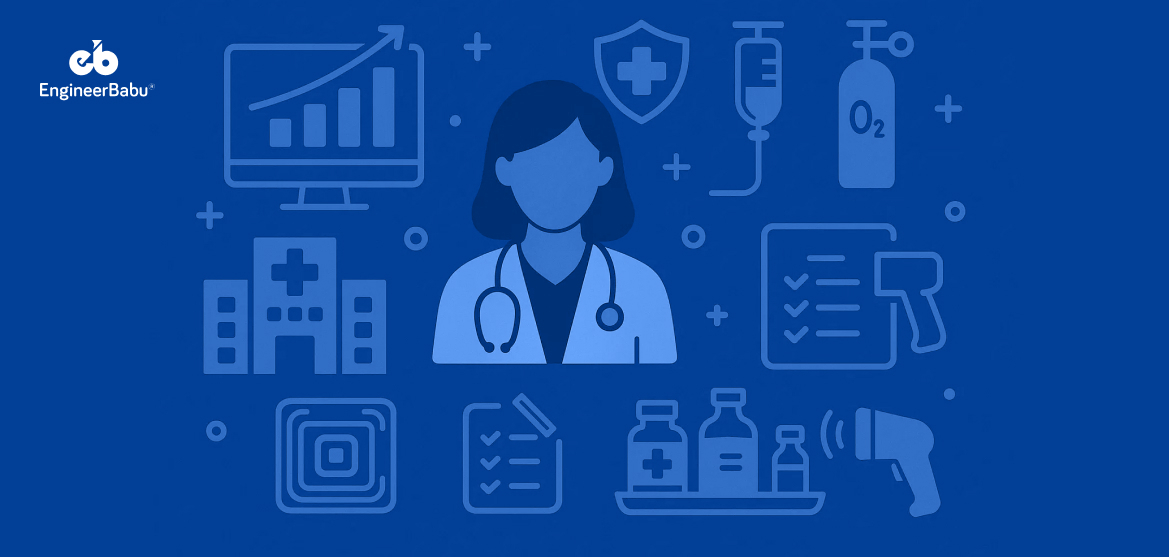It’s 4:12 AM. A patient in the ICU needs a ventilator. The nurse on duty checks the usual room. It’s not there. She calls two other wards. Still nothing. Ten minutes pass before she finds one down the hall — unplugged and unmaintained.
This isn’t rare. It’s the norm in many hospitals.
Every missing or untracked piece of equipment chips away at care quality, staff morale, and the bottom line. That’s why healthcare asset management is a crucial part of healthcare systems.
In this post, we’re breaking down the hard-hitting benefits of healthcare asset management. You’ll see how the right system turns chaos into control, slashes downtime, and helps care teams focus on what they actually came to do — treat people.
What is Healthcare Asset Management?
Healthcare asset management is the system hospitals use to track, maintain, and optimize medical equipment and devices.
It includes tools and processes to monitor where equipment is, how often it’s used, and when it needs repair or replacement. These assets range from high-cost machines like MRI scanners to everyday items like wheelchairs and infusion pumps.
Most systems use technologies like barcodes, RFID tags, and cloud-based platforms. These help staff quickly find what they need, avoid duplicate purchases, and reduce downtime from missing or broken equipment.
Hospitals using asset management can prevent delays in care, extend the life of equipment, and cut operational waste.
Benefits of Healthcare Asset Management
Faster Equipment Access
Hospitals run on tight timelines. Every minute counts when moving a patient into surgery or responding to a critical care alert. Yet in many facilities, staff still rely on guesswork or word-of-mouth to locate essential devices. With asset management systems, every piece of equipment is tagged and tracked in real time. Staff can check a screen and know exactly where to find a portable monitor or infusion pump — without wasting 15 minutes walking across departments. That kind of visibility speeds up care and reduces stress during emergencies.
Fewer Equipment Breakdowns
A significant number of equipment failures in hospitals are due to preventable causes. According to the World Health Organization (WHO), approximately 60% of medical equipment failures are attributed to inadequate maintenance practices.
Implementing a robust asset management system addresses these issues by scheduling regular maintenance, ensuring timely repairs, and tracking equipment performance. This proactive approach not only reduces unexpected breakdowns but also extends the lifespan of critical medical devices, ensuring they are available and functional when needed most.
Lower Operational Costs
Every time a hospital misplaces a device, it risks buying a replacement or renting an extra one. Over a year, these costs stack up. Asset management helps by showing what’s already available, where it is, and how often it’s used. Hospitals can avoid double purchasing, rotate underused assets, and retire items that aren’t worth keeping. This not only lowers direct equipment costs but also improves budgeting accuracy across departments.
Better Staff Productivity
When equipment is hard to find or unavailable, it slows everything down. Nurses have to make extra calls, walk longer distances, or delay procedures. This eats into their time and energy. With reliable asset tracking, staff know what’s available and where to find it. That means fewer interruptions and smoother handoffs between shifts. It also reduces frustration and burnout, especially in high-pressure departments like emergency or intensive care.
Improved Patient Safety
Missing or malfunctioning equipment can lead to real harm. For example, if a defibrillator isn’t charged or calibrated, it can delay treatment during a cardiac event. Asset management systems help avoid these risks by keeping track of maintenance history, cleaning status, and current location. Devices are checked, serviced, and ready when needed. That boosts patient safety, reduces the chance of medical errors, and improves trust between patients and caregivers.
Stronger Compliance and Audit Readiness
Healthcare regulations require strict documentation of equipment use and maintenance. During inspections or audits, missing records can lead to penalties or loss of certification. Asset management systems automatically log service dates, repair notes, and location changes. This creates a clear trail of compliance without extra paperwork. When auditors show up, everything is already documented — and easy to share.
Conclusion
Most hospitals already have the tools to deliver excellent care. What they often lack is the visibility to use those tools when and where they’re needed. That’s the gap asset management fills — not by adding more equipment, but by making every existing asset count.
The benefits aren’t theoretical. When nurses stop spending 30 minutes per shift hunting for equipment, patient wait times drop. When a maintenance log prevents a machine from failing mid-procedure, outcomes improve. When hospitals stop reordering gear they already own, budgets finally make sense.
For healthcare providers, this means smoother operations and safer care. For healthtech companies, it’s a clear signal: build products that solve for visibility, not just volume.
FAQs
How does asset management improve hospital efficiency?
It reduces the time staff spend searching for equipment, prevents unnecessary purchases, and keeps machines running with scheduled maintenance. This frees up time and resources for direct patient care.
Can small hospitals benefit from asset management systems?
Yes. Even small facilities lose money and time due to misplaced or poorly maintained equipment. Basic asset management tools can deliver strong ROI by improving usage and reducing waste.
What kind of equipment can be tracked?
Anything from surgical tools to wheelchairs to high-value machines like MRI or CT scanners. Some systems also track IT equipment and consumables like IV stands and syringes.
Is it hard to implement a system like this?
Initial setup can take time, especially tagging and logging all assets. But once in place, most systems are easy to maintain and offer long-term savings and operational improvements.
Does it help with patient outcomes?
Yes. Reliable access to well-maintained equipment reduces treatment delays and medical errors, which directly improves patient safety and satisfaction.




